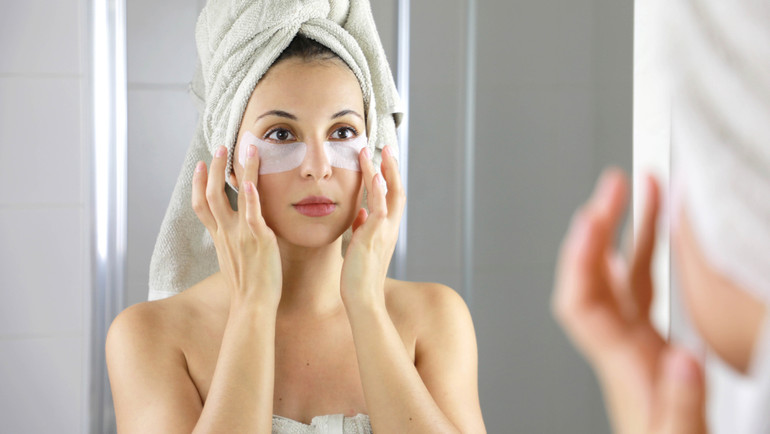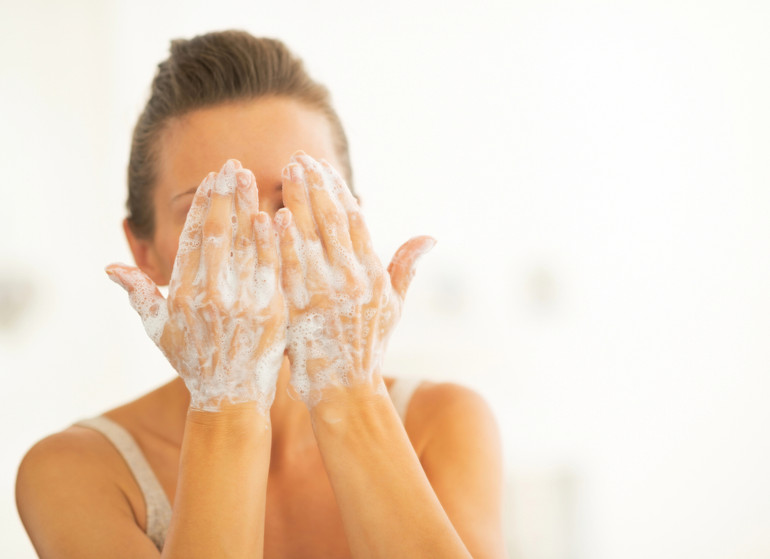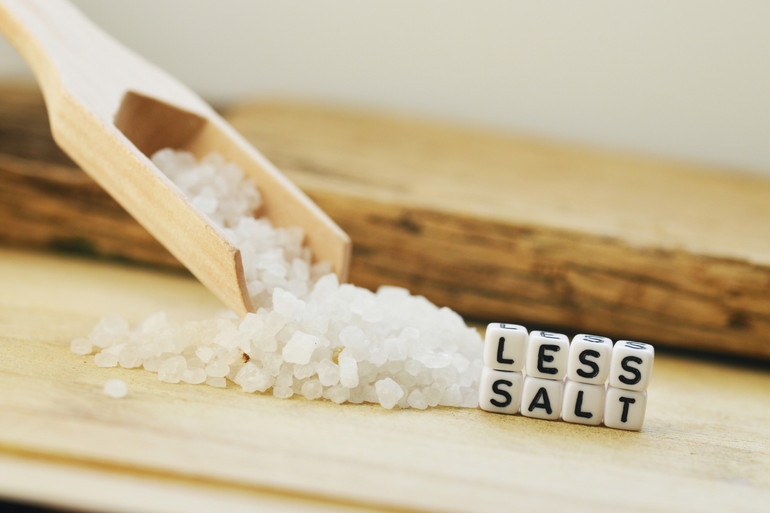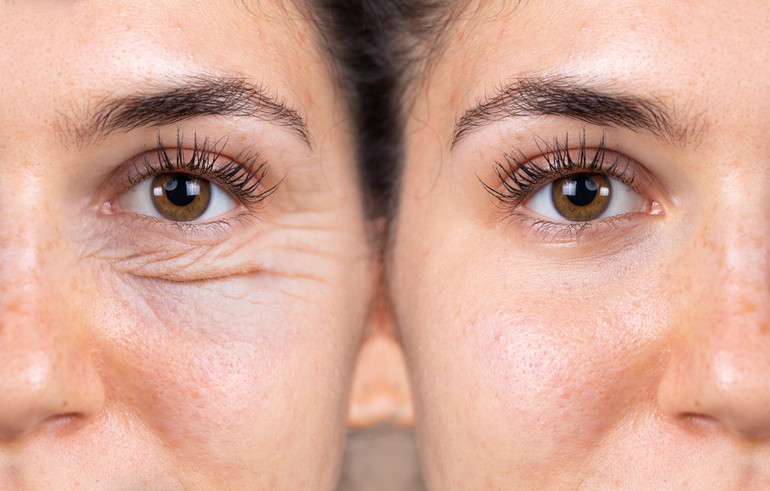How to remove bags under the eyes and why dark circles appear
[ad_1]
Puffiness under the eyes in the morning often bothers those who stays up late at work, eats really salty food in the evening, or has been lacking sleep for a long time.
What are the other reasons for the appearance of bags under the lower eyelids? Is it possible get rid of dark circles under the eyes and how to do it in the easiest way to look fresh in the morning?
“UP. Life” described causes of puffiness under the eyes and how to remove these “bags”using sources: Mayo Clinic, Healthline, MedicalNewsToday and American Academy of Ophthalmology.
What do the “bags” under the eyes look like
These are light swellings under the lower eyelid. Bags under the eyes are usually a cosmetic problem that is rarely a sign of a serious medical condition.
Signs of such a problem may be:
- slight swelling;
- sagging or laxity of the skin;
- dark circles under the eyes.
Why do they appear? dark circles and swelling under the eyes
Although anyone can have dark circles under the eyes, older people are more prone to it. Bags under the lower eyelids appear with age, when the tissues around the eyes weaken. The skin may begin to sag and the fatty tissue that is normally found around the eyes may move to the area below them. Due to the loss of collagen and thinning of the skin, the blood vessels under the lower eyelids become more visible.
In addition, fluid may accumulate under the eyes, making the area look swollen or puffy.
Factors that cause or worsen the effect of bags under the eyes at any age are:
- fluid retention (especially after waking up or eating salty food);
- lack of sleep;
- the presence of allergies;
- smoking;
- chronic fatigue;
- the influence of the sun;
- genetic predisposition (bags under the eyes can be inherited);
- diseases (dermatitis, dermatomyositis, kidney and thyroid diseases).
Due to the loss of collagen and thinning of the skin, the blood vessels under the lower eyelids become more visible.
Methods that will help make bags under the eyes less noticeable
Get rid of bags under the eyes forever impossible, but you can reduce their visibility with certain practices and topical remedies.
1. Application of cool compresses
Applying cold to the area under the eyes can help the blood vessels to constrict quickly, providing temporary relief and helping remove bags under the eyes for a certain time.
You can buy patches to fight dark circles under the eyes, or try to make them yourself.
Wet a clean cloth with cool water. Sit up straight, put a cool compress under your eyes, pressing very gently. It is enough to apply the compress for only a few minutes to see the results.
2. Maintenance of water balance
Dehydration can contribute to the appearance of bags under the eyes. About half of the world’s people are not used enough water every day.
How much water is enough? Recommendations vary from 6 to 12 glasses (1.5 – 3 liters) and depend on many factors:
- age;
- activity level;
- climate;
- gender;
- the presence of diseases or pregnancy.

Applying cold to the under-eye area can help the blood vessels to constrict quickly, providing temporary relief and helping to get rid of under-eye bags for a period of time.
3. Use of sunscreens
Protecting your skin from the sun’s rays can help prevent dermatological problems:
- premature aging;
- skin cancer;
- changes in skin color.
As a result, the use sunscreen cream can also help get rid of dark circles under the eyes.
You can avoid the harmful effects of the sun’s rays by following several rules:
- to be in the shade;
- wear protective clothing;
- avoid solariums;
- be careful around water, snow and sand, which can increase the risk of sunburn.
4. Washing before going to bed
It is important to wash your face every night before going to bed, especially if you use cosmetics.
If you sleep with mascara or other makeup on your eyes, you can:
- cause their irritation;
- cause an allergic reaction;
- carry an infection that causes redness, swelling, or other symptoms.
Sleep with cosmetics on the face may cause wrinkles or damage the skin. When you sleep with makeup on, you expose your skin to free radicals. This causes so-called oxidative stress, which leads to faster signs of aging.

It is important to wash your face every night before going to bed, especially if you use cosmetics.
5. Sufficient sleep
Insufficient amount sleep may not cause under-eye circles, but lack of sleep can make your complexion look paler. As a result, any shadows or dark circles under the eyes become more noticeable.
Most adults should aim for 7 to 8 hours of sleep each night.
It is also worth following sleep hygiene rules:
- fixed sleep schedule (time of waking up and falling asleep), including weekends;
- maintaining darkness and moderate temperature in the bedroom;
- comfortable mattress and pillow;
- daily physical exercises, but no later than 2 hours before bedtime;
- avoiding watching TV in the bedroom;
- reducing caffeine and alcohol consumption, especially in the evening;
- refusal of a heavy evening meal;
- avoiding electronic devices, including cell phones, at least half an hour before bedtime.
Try taking a hot bath or shower before bed or using other relaxation techniques.
Also, to fight bags under the eyes, you can raise your head while sleeping with the help of an additional, slightly higher pillow or raise the head of the mattress. It helps prevent fluid retention under the lower eyelids, which leads to puffiness during sleep.
6. Eating foods rich in vitamin C and iron
With age, the muscles and tissues that support the eyelids weaken. The skin begins to sag, including the fat that is usually found around the eyes.
Consuming vitamin C helps the body absorb more hyaluronic acid. This substance is naturally found in the body, but with age, its amount decreases. Foods rich in vitamin C can also promote collagen production, improving the appearance of skin.
Good sources of vitamin C are:
- oranges;
- Red pepper;
- cabbage;
- Brussels sprouts;
- broccoli;
- Strawberry.
Lack of iron in the body (iron deficiency anemia) can also cause dark circles under the eyes and even pale skin. Other symptoms of iron deficiency:
- severe fatigue;
- cold hands and feet;
- brittle nails.
A doctor can check for anemia with a blood test. Depending on the severity, the specialist will recommend eating more iron-rich foods or taking iron supplements to restore normalcy.
Foods rich in iron:
- red meat, pork and poultry;
- seafood;
- beans;
- leafy green vegetables such as kale and spinach;
- raisins and other dried fruits;
- cereals, bread and pasta;
- pea.
7. Reducing the amount of salty food in the daily diet
Eating too much salty food can contribute to the appearance of bags under the eyes. Salt affects fluid retention in the body – the appearance of swelling.
It is recommended to consume 2,300 milligrams (mg) of salt or less daily. Ideally, adults should consume no more than 1,500 mg of salt per day.
One way to immediately reduce the amount of salt in your diet is to stop eating processed foods. Instead, try eating a diet that includes fresh fruits and vegetables, where you can control your salt intake.

Eating too much salty food can contribute to the appearance of bags under the eyes. Salt affects fluid retention in the body – the appearance of swelling.
8. Refusal of smoking and alcohol
Alcohol and smoking can cause dark circles under the eyes as well. Fighting these bad habits will have a positive effect on the condition of the skin under the eyes and the body in general.
Drinking alcohol contributes to dehydration, and it can lead to the appearance of bags and dark circles under the eyes.
Nicotine in cigarettes depletes the supply of vitamin C, which is responsible for the formation of collagen in your skin. If you smoke, you may face the following problems:
- wrinkles;
- change in skin color;
- puffiness and dark circles under the eyes.
When to see a doctor if you have bags under your eyes
Usually, bags under the eyes are harmless and do not require medical attention. See your doctor if the condition causes vision problems, irritation, headaches, or is accompanied by a skin rash.
The doctor will rule out other possible causes that may contribute to swelling:
- diseases of the thyroid gland;
- kidney disease;
- diseases of the cardiovascular system;
- infection;
- connective tissue diseases;
- allergy.
Allergic swelling under the eyes may be accompanied redness, lacrimation and itching of the eyes. This reaction is caused by your immune system reacting to the allergen. If you think that the bags under the eyes may be related to allergies, contact your doctor for the prescription of antihistamines. It’s also a good idea to avoid potential allergens whenever possible.
If the bags under the eyes are not accompanied by any disease and are only a cosmetic problem, home procedures and lifestyle changes can help reduce puffiness and visually improve the condition of the skin under the eyes.
There is also a large number for eliminating bags under the eyes cosmetics. Although the label says they help smooth out puffiness and lighten the skin under the eyes, they don’t always work. This is especially true if bags under the eyes and dark circles are inherited genetically.
If necessary, you can turn to a dermatologist for adviceeffective means or facial treatments.
If swelling under the eyes does not disappear or really bothers a person, surgery may be necessary operation on the eyelids (blepharoplasty). The procedure involves removing excess fat. At the same time, it is worth discussing with the doctor the side effects of eyelid surgery – dry eyes, tearing, pain, swelling, bruising, and blurred vision. Rare complications include vision loss, bleeding, infection, eye muscle injury, and eyelid droop.

If swelling under the eyes does not go away or really bothers a person, eyelid surgery (blepharoplasty) may be necessary.
[ad_2]
Original Source Link











